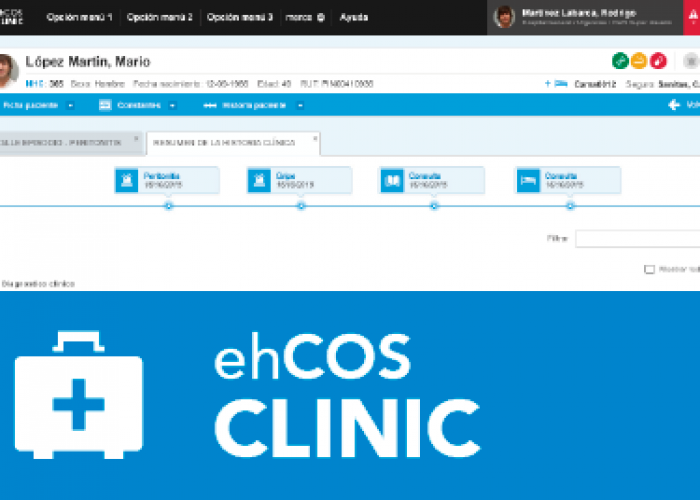Usability in Healthcare Software: From Myth to Fact


We have never been allowed to lose sight of the fact that the main purpose to be served by the Clinic is the care of the sick. William J. Mayo.
Information and communication technologies have significantly impacted the healthcare industry in recent decades. According to the Organization for Economic Co-operation and Development, known by its acronym OCDE1, the increase in the quality of patient care and safety, the improvement in efficiency and the decrease in operational and administrative costs of organizations, as well as the implementation of new health services, constitute some of the demonstrable benefits.
For most modern healthcare organizations, information technology and Electronic Health Record systems play essential roles in the care process and facilitate the day-to-day work of professionals, communication with patients, coordination of care, creation of new services and improvements in the efficiency of the organization, among others.
However, in certain countries and regions where there is widespread adoption of electronic health records, oftentimes backed by economic incentives, numerous studies continue to warn us about the negative impact of usability issues in the use of technology that highlight security risks for the patient 2,3.
Before analyzing some of the causes, we should begin by defining what we mean by usability in health information technology and, better yet, what it is not.
Misunderstanding Usability
An article published several years ago in Healthcare Usability 5, debunking some common myths concerning usability, continues to be very timely.
Although they are self-explanatory, some of these myths are so ingrained that they need to be examined.
Myth #3 – The more functionality, the better
This myth is tempting, especially in systems such as Electronic Health Records that feature considerable functional loads that can lead directly to usability failures. Software functionality design should be based on prior user research, in their real use environment, where this type of software should be able to help them perform their tasks more effectively and in less time.
Creating functionalities focusing on the market and not on the use is an error. It would be more suitable to think that “more is less”, in this case.
Myth #6 Usability is subjective
This is a myth that cannot be further from reality. Usability issues, in addition to causing frustration, lead to a loss of efficiency and effectiveness during the care process, and predisposes to error. Usability can be measured through different techniques, such as usability tests that measure the execution of workflows at a certain time and detect failures and errors, and are complemented by other methodologies, such as the SUS Scale (System Usability Scale), PSSUQ, among others.
Myth #7 Usability is the same thing as coloring screens, applying styles, and pretty designs
Perhaps this myth is one of the most sadly extended ones and minimizes the importance and the commitment of technology providers to offering the user the best software-use experience.
To design the user interaction with a system or application, we need to know and optimize the task flow that each profile performs, meet their expectations and needs and above all, provide an environment that is as natural and simple as possible to execute these tasks quickly, easily and securely. This includes the visual design of the interface, obviously, but that is only part of the experience.
The scope of usability in health information technology
The ISO defines usability as the extent to which a product can be used by specified users to achieve specified goals with effectiveness, efficiency, and satisfaction in a specified context of use 6.
In the case of technologies developed for the healthcare industry, usability takes on a special dimension.
Studies show that patients treated with the help of a well-designed and usable Electronic Health Record, have between 17% and 30% less chance of experiencing an adverse event, which suggests that hospitals that possess this technology are capable of providing more coordinated patient care from admission to discharge, and increase patient safety.
The problems stemming from a lack of usability have a negative impact on the quality of patient care and the doctor – patient interaction, frustrating health professionals. Poor usability also increases the time spent documenting the care process, and interferes with patient care.
On the other hand, poor understanding of the context of the use of information during software development can lead to an overload of information that hinders decision making 9,10,11,12.
Such is the magnitude of this problem, that the ECRI (Emergency Care Research Institute), ranked this in sixth place in “the 10 risks of the use of Electronic Health Record”, specifically the risk stemming from the poor design and poor execution of the work flows in the Health Record; “alarm fatigue” due to misconfiguration, and concerns about the integrity of the data 13.
Usability in a critical sector for security
The healthcare industry is highly sensitive to security. Countries such as the United States are studying ways to implement best usability practices in the Electronic Health Record systems, as well as security policies based on the experiences in other complex industries such as nuclear, aeronautics, energy extraction, military and finance 14 15.
There is no doubt that technology must be designed, developed and implemented focusing on its usability and safe use, based on design processes that focus on the user and their experience (UCD), a commitment that suppliers must subscribe to, with their users.
Another example of the importance of this topic for the industry is a new research project by the Agency for Healthcare Research and Quality in the United States (AHRQ), funded with a budget of $1,225,562 USD, which aims to develop new guidelines for the implementation and design of software that is user-focused and evidence-based, with the aim of helping health technology providers to continue improving the usability of information technologies 16.
Health information technologies will increasingly focus on people
In the digital economy, the patient’s experience is at the core of the transformation process, and in that sense we are called to maximize their experience, designing interactions that are increasingly based on human behavior 17.
The future has already arrived and reveals a scenario where technology adapts more and more to the user and learns from their behavior. For this reason, many experts are already talking about how the new user interface (UI) will be converted into AI (Artificial Intelligence) 18.
The present-day experience of the user looking up information in a previously organized structure, interacting through keyboards or buttons with a device, will become a more natural, human and personalized experience, where the user interacts with more conversational interfaces.
We are convinced that contextual intelligence and continuous learning algorithms will soon guide the interaction process of patient and health professional with technology, providing a better experience and maximizing the benefit and value that they already contribute.
This article is part of the Whitepaper: “Improving usability and optimizing the experience of health professionals and patients through the use of health information technologies”, awaiting formal publication.
References
1 Organization for Economic New Health Technologies (2017). Managing Access, Value and Sustainability. OECD Publishing, Paris.ISBN: 9789264266438 [on line]
2 A. Kushniruk, J. Kaipio, M. Nieminen, H. Hyppönen, T. Lääveri, C. Nohr, A. M. Kanstrup, M. Berg Christiansen, M.-H. Kuo, and E. Borycki1. Human Factors in the Large Experiences from Denmark, Finland and Canada in Moving Towards Regional and National Evaluations of Health Information System Usability. Yearb Med Inform. 2014; 9(1): 67–81. Contribution of the IMIA Human Factors Working Group [on-line]
3Jennifer Zelmer, Elettra Ronchi,Hannele Hypponen,Francisco Lupiañez Villanueva, et all. Benchmarking Pilot Group. International health IT benchmarking learning from cross country comparisons. Journal of the American Medical Informatics Association , 24(2), 2017, 371–379 [on line]
4 Raj Ratwani, Ph.D. Director científico del Centro Nacional de Factores Humanos en Salud MedStar. Washington DC.
5 Healthcare Usability. (2013). Top 10 healthcare Usability Myths Debunked. [on line]
6 ISO 9241-11:1998 “Guidance on usability” https://www.iso.org/standard/16883.html.
7 Jennifer Bresnick. Can Full EHR Adoption Decrease Adverse Patient Safety Events? Adverse patient safety events are significantly less common in hospitals using a fully electronic EHR system, new AHRQ research suggests. [on line]
8 Furukawa, Michael F. PhD; Eldridge, Noel MS; Wang, Yun PhD; Metersky, Mark MD. Electronic Health Record Adoption and Rates of In-hospital Adverse Events. Journal of Patient Safety: Post Author Corrections: February 6, 2016. [on line]
9 Boland MV. How Much Time Should We Be Spending With Electronic Health Records?. JAMA Ophthalmol. Published online October 12, 2017. [on line]
10 Yang DX, Kim YA. Patient-Physician Interactions and Electronic Health Records. JAMA. 2013;310(17):1857. [on line]
11 Mitka M. Physicians Cite Problems With EHRs. JAMA. 2014;311(18):1847. [on line]
12 Ratanawongsa N, Matta GY, Lyles CR, Koenig CJ, Barton JL, Yu K, Schillinger D. Multitasking and Silent Electronic Health Record Use in Ambulatory Visits. JAMA Intern Med. 2017;177(9):1382–1385. [on line]
13 ECRI Institute. Top 10 Health Technology Hazards for 2016. [on line]
14 Savage EL, Fairbanks RJ, Ratwani RM. Are informed policies in place to promote safe and usable EHRs? A cross-industry comparison. J Am Med Inform Assoc. 2017 Jul 1;24(4):769-775. [on line]
15 Wears R.L. Rethinking healthcare as a safety–critical industry. Work. 2012;41 Suppl 1:4560-3. [on line]
16 Developing Evidence-Based, User-Centered Design and Implementation Guidelines to Improve Health Information Technology Usability (Maryland) MedStar Research Institute. R01 HS023701. 30/09/2015 al 31/7/2020. [on line]
17 [Whitepaper] Mario Chao. Los retos de la transformación digital para las organizaciones de salud. ¿Cómo Innovar y permanecer competitivos en tiempos de cambios acelerados? [on line]
18 Accenture. Design for humans. Inspire new behavior.[on line]
Resources
-

ehCOS CLINIC
A next-generation Health Record, integrating the latest trends. More information -

Expert opinion
Usability allows doctors and nurses to focus on the patient, Video
.png)





